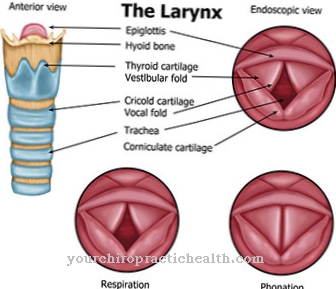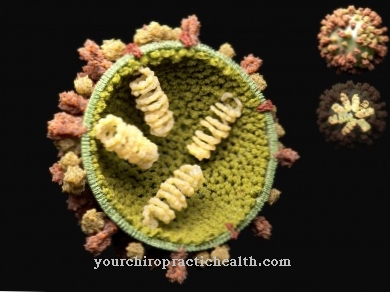The hard or the soft Corns or. Crow's eye is a preventable foot condition. Too tight shoes, constant friction or chronic pressure cause it. One could call the corn a common disease. But it is not a disease in the strict sense. The propensity for orthopedically unsuitable footwear is the real reason why a corn develops.
What are corns?

A Corns occurs as a callus on the surface of the toes, on the sides of the toes or occasionally on the ball of the foot. The painful callus is triggered by repeated pressure on the skin on the foot.
If the corn sits between the toes, it is called the inter-toe corn.
Two types of corn are known:
The hard and the soft. They do not differ from one another in terms of the degree of pain and causes. The treatment of the hard or soft corn can be different.
causes
A Corns is favored by too tight shoes. Constant rubbing of the toes in a shoe that is cut too tightly causes corns between the toes. The rubbing of the toe surfaces on the shoe material can also cause a corn - in the worst case one on each toe. The real cause of the corn is a bruising of the skin. One or more corns are diagnosed much more often in women who prefer to wear pointed or tight shoes.
Symptoms & course of disease
The hard one Corns usually occurs where shoes that are too tight are most likely to cause friction on the foot. It is found on the surfaces of the toes, sometimes on the tips of the toes or on the side of the toes. But you can also develop a hard corn on the ball of the foot where the shoe pinches.
It is about the size of a pea and may be red and shiny. The hardness of the corn is noticeable when touching it. Its color is yellowish. Under the magnifying glass you can see a core that has grown inwards. The pressure on the core causes the familiar, sharp pain.
The soft corn feels significantly different. It arises for the same reasons and preferably between the toes rubbing against each other. The surface of this corn is rather soft, the hard core is missing. The degree of pain is the same for both types of corn.
It increases with friction and sweating on the foot. People who have flat feet or splay feet, wear unsuitable footwear or suffer from osteoarthritis of the joints are more likely to have corns than people with healthy feet.
The corn must be distinguished from a wart caused by viruses in the same places. A corn can be dangerous in diabetes. Here one does not notice friction and pain due to the diabetic foot. In combination with diabetes, the corn can become inflamed and cause serious consequential damage.
Complications
A corn is created by strong stress in a certain area, so that the skin is protected from further injuries. Of course, such a corn can also cause various complications that may also need to be treated by a doctor. In many cases, a corn causes an infection that should always be treated with medication.
If the affected area continues to be stressed, an open wound can develop. An inflamed corn is always at risk of inflammation, as bacteria and viruses can lodge in the open wound. For this reason, an appropriate doctor should be consulted at the first signs of inflammation. Failure to visit the doctor at this point exposes the person to great danger.
The complication at hand can worsen considerably, so that it can even lead to the formation of pus fluid. Another possible complication is the formation of a crack. A crack is a deep crack in the skin that unfortunately can no longer grow together on its own. Even with this complication, a visit to the doctor is inevitable.
Failure to do so may cause repeated inflammation, which may include a build-up of pus fluid. However, those who treat the above-mentioned complications with medication at an early stage have a very good chance of a full recovery.
When should you go to the doctor?
If there are pressure points or skin changes on the foot, they can often be treated with independent care. Wearing tight and unhealthy shoes should be avoided and in many cases can already help improve symptoms. Foreign bodies in the shoes must be removed immediately. In addition, special foot baths and commercially available care products such as ointments or creams are helpful to heal the skin changes. If this does not succeed within a few weeks, a doctor's visit is advisable. If a corn develops, there is a risk of spreading without treatment. If the pressure points on the foot increase or if they spread further, a doctor should be consulted.
If pain begins when the foot is stepped on or if there are problems with motor locomotion, medical care should be provided for the injured area. Consult a doctor if the body is incorrectly positioned, unsteady gait or if the body is unilateral. Muscle complaints, restricted mobility or problems in performing sports activities should be examined and treated by a doctor. If emotional irregularities set in in addition to the physical complaints, a doctor should be consulted.In the event of mood swings, increased irritability or withdrawal behavior from familiar social activities, a visit to the doctor is essential.
Doctors & therapists in your area
Treatment & Therapy
You can do it hard Corns Treat yourself by applying a salicylic acid solution. This softens the horn-like hardened surface. After several treatments, the corn can then be carefully peeled off in warm water. As an alternative to the liquid solution, you can buy corn plasters in the pharmacy or drugstore.
However, this treatment is not recommended for soft corn. Diabetics and patients with circulatory disorders are also not allowed to use salicylic acid preparations. Going to the podiatrist, orthopedic surgeon, dermatologist or podiatrist can be helpful here. You go to these instances even if the corn never arises.
Surgery may be necessary for very painful, hard corns with a deep core. A pressure protection plaster or an inter-toe plaster can be useful to avoid a new development. A new corn is thus prevented.
prevention
Home remedies ↵ for corns To prevent one Corns Well-fitting footwear is essential. It must neither rub nor press. If you notice a pressure point in the toe area, you can preventively pad the corresponding toe. But it would be better to change the shoe or let it expand. Sometimes orthopedic insoles or special shoes for diabetics help. In addition to the classic friction problem, misalignments of the toes, foot problems or an inappropriate gait can also lead to a corn.
Aftercare
After the corn has been professionally removed, the affected area of skin must be protected from pressure and friction. Foam inserts for shoes, soft socks or so-called corn rings made of foam, which are placed on the affected area, are suitable for this. In addition, prophylactic measures must be taken during follow-up to prevent the development of a corn again.
In addition to the right footwear, regular foot care is also of great importance. To do this, it is important to wash and cream your feet regularly and remove excess callus. This prevents excessive stress and corns. The removal of excess callus can be done at home.
The callus can be easily removed after a warm foot bath of ten to fifteen minutes with a callus file or a pumice stone. If corns have occurred frequently in the past, regular medical foot care in a podiatry is advisable. If, on the other hand, shoes that are too tight or uncomfortable are suspected to be the cause, it makes sense to consult an orthopedic surgeon about the right footwear.
Orthopedic insoles, orthopedic shoes or other orthopedic aids can protect the endangered regions. In addition to protecting the affected area, after the corn has been removed, the main thing to do is to eliminate the causes in order to avoid recurrence.
You can do that yourself
A hard or soft corn is easy to treat yourself. An immediate visit to a specialist is recommended only for diabetics.
Usually the corn can be softened with the help of a salicylic acid solution. The solution can be bought over the counter in pharmacies. Those affected should take several foot baths with this solution and then try to remove the softened skin. The skin can also be carefully worked with a pumice stone or a fine-pored foot grater. However, care should be taken not to remove too much skin. If the area starts to bleed, it provides an inlet for bacteria and viruses and the basis for inflammation. Diabetics and patients with known circulatory disorders should not use salicylic acid.
Alternatively, special plasters are available in drugstores and pharmacies, which can be stuck onto the affected area. The most important point in self-treatment, however, is the right footwear. Shoes that are too tight or materials in which there is strong perspiration have a beneficial effect on the development of a corn. Those affected should prefer natural, breathable materials with a comfortable foot width. Special pressure protection plasters - such as those offered in shoe stores, drugstores and pharmacies - prevent corns from developing again.
In naturopathy, corns are treated with lemon, tea tree oil and onions. These substances also have an anti-inflammatory effect and loosen the keratinized skin area.


.jpg)


.jpg)
.jpg)

















.jpg)



